
This Newsletter presents you the principal events concerning ALADIN during the quarter of year mentioned above. The news about work or events outside Toulouse are related with informations that you sent (for disponibility constraints, the "deported" work deals with the previous quarter).
So, reading this Newsletter, you will know everything about ALADIN activities (more precisely everything I was told about) between July 1998 and September 1998 (except for the work realized outside Toulouse : between April 1998 and June 1998).
Please do bring to my notice anything that you would like to be mentioned in the next Newsletter (number 13) before the 15th of January 1999.
Any contribution concerning announcements, publications, news from the ALADIN versions on workstations or on big computers, verifications results, ... will be welcome. This deadline is particularly important for the report of the deported work each representative should sent every quarter.
If needed, please contact :

|
|
|
| |
Many thanks for all of you who have sent me most of the informations reported here.
Contents
Main events ................................................................. 3 1. Last modifications for the operationally running ALADIN configurations.... 3 2. Future modifications for the operationally running ALADIN configurations.. 3 3. Phasing strategy for the next weeks/months................................ 3 Conferences/Workshops/Announcements.......................................... 4 1. Third Assembly of the ALADIN Partners held in Praha on November the 6th, 1998................................................. 4 2. EWGLAM/SRNWP meetings held in Copenhagen on October 5-9th, 1998.......... 5 3. "Atelier de Modélisation de l'Atmosphère" to be held in Toulouse on December 8-10th, 1998.................................................. 5 4. Sixth ALADIN Workshop to be held in Bucarest on February 15-17th, 1999.... 5 Contacts & Informations...................................................... 6 Money Funding asked for some cooperations based on the ALADIN project........ 6 1. INCO-COPERNICUS keep-in-touch, so-called "ALADIN-KIT" .................. 6 2. Embassies support ........................................................ 6 3. Météo-France support for maintenance ..................................... 7 The (pre-) operational ALADIN models ........................................ 7 1. The AWOC-group ........................................................... 7 2. ALADIN in Austria ........................................................ 8 3. ALADIN-BELGIUM ........................................................... 8 4. ALADIN in Bulgaria ....................................................... 9 5. ALADIN-FRANCE ............................................................ 9 6. ALADIN Workstation version at Météo-France............................... 12 7. ALADIN in Hungary ....................................................... 13 8. ALADIN-LACE in CHMI ..................................................... 13 9. ALADIN-MAROC ............................................................ 15 10. ALADIN in Poland ....................................................... 15 11. ALADIN in Portugal ..................................................... 15 12. ALADIN in Romania ...................................................... 15 13. ALADIN in Slovakia ..................................................... 16 14. ALADIN in Slovenia ..................................................... 18 "Réseau Formation Recherche" : PhD Studies ............................... 19 1. Doina Banciu ............................................................ 19 2. Marta Janiskova ......................................................... 20 3. Ilian Gospodinov ........................................................ 21 4. Filip Vana .............................................................. 21 5. Mark Zagar .............................................................. 22 Verification of ALADIN-LACE area precipitation ............................. 22 Scores on ALADIN-FRANCE during the third quarter of 1998 ................... 22 Participations in the ALADIN project : some statistics...................... 24 Deported developments during the second quarter of 1998 .................... 26 1. in Austria .............................................................. 26 2. in Belgium .............................................................. 26 3. in Bulgaria ............................................................. 26 4. in Croatia .............................................................. 26 5. in Czech Republic ....................................................... 26 6. in Hungary .............................................................. 27 7.in Moldavia .............................................................. 27 8.in Morocco ............................................................... 27 9. in Poland ............................................................... 27 10. in Portugal ............................................................ 27 11. in Romania ............................................................. 28 12. in Slovakia ............................................................ 28 13. in Slovenia ............................................................ 28 14. by Météo-France people ................................................. 28 ALADIN developments in Toulouse during the third quarter of 1998 ........... 28 1. Main events in Toulouse this quarter .................................... 29 2. Other visitors research or development studies .......................... 29 3. Other Research or development studies by the Toulouse permanent staff.... 29 Annexes .................................................................... 30 1. List of the documents available on the public ftp ....................... 30 2. Total participation : breakdown of person.months by countries ........... 31 3. Toulouse/Deported work since the last quarter of 1995 ................... 32 4. Total participation : breakdown of the Toulouse/Deported person.months by countries .............................................. 33 5. Evolution of the Toulouse monthly manpower .............................. 34
1. Last modifications for the operationally running ALADIN configurations
|
|
In order to better use the resources of the Fujitsu VPP in Toulouse, ARPEGE resolution changed on September the 1st (see details on page 9). At the same time, the size of the ALADIN-FRANCE domain increased and its grid mesh decreased. | |
|
This change of 27 to 31 levels had an impact on the operationally running deported ALADIN models. Everything went well thanks to the joint efforts of the ALADIN contact points for operational or pre-operational applications. |
| |
2. Future modifications for the operationally running ALADIN configurations
|
|
A coordinated change of the so-called clim files used by configurations E927, EE927 and post-processing is scheduled for November 19th. The high resolution dataset used to define vegetation characteristics over Europe has been modified using a fine forest mask. This implies small changes over the area covered by the previous database, and a significant extension of the domain of detailed data, especially eastwards and northwards. |
3. Phasing strategy for the next weeks/months
|
During the last phasing (June and July 1998), ALADIN cycle 9 was created. It is based on ARPEGE cycle 19. The following phasing was planned for November and December 1998 with the aim of creating ALADIN cycle 10 (AL10) based on ARPEGE cycle 20 (CY20).Waiting for CY20, an ARPEGE preliminary library (preCY20) should be used at the beginning of this phasing. It appears that we will not meet the deadline and that some revised strategy will have to be found. |
| |
|
Given the Météo-France support available for maintenance and given the 2-3 week delay in preCY20 (and more than 1 month for CY20), a second phasing is likely to be organized in February for the completion of the CY20/AL10 validation. | ||
|
at short range, the initial strategy is kept : the aladin-people start to phase the source code once preCY20 is ready, while the arpege-people validate the global model libraries. | ||
|
|
at medium range, after the final aladin validation next year, the cleaning cycle CY21/AL11 will be performed. there will be a need simply to decide whether arpege and aladin are cleaned together (after the aladin validation) or separatly (arpege cleaning first, and only aladin cleaning after the AL10 validation - see later on with gourous). at long range, there should be only one ARPEGE cycle scheduled for 1999: CY22 including major changes in observations management (with the ODB database in replacement of CMAFOC files). | |
1. Third Assembly of the ALADIN Partners held in Praha on November the 6th, 1998
This Assembly was a success (of course !...) but you will have to wait next Newsletter (number 13, events during the last quarter of 1998) to know all details about it. As a preliminary very short report, please just note that :
|
|
The scientific medium term plan has been accepted, though the manpower was not discussed. Other topics (code maintenance, closer coordination for applications, ...) were addressed but without getting to a conclusion. For the coming year, a 3-headed team has been created to initiate and coordinate the exchanges, collect proposals and prepare the discussions for the next Assembly of partners. In the future, a strict rule will be followed to count each country's participation in the project: those who have not answered during the 3-months' delay will get a 0-contribution; one official focal point per Partner will be intrusted; a request will be sent soon to every Directors. From the next quarter, statistics will not only be drawn up for Toulouse part, Deported part and Total part of the ALADIN project but also for the LACE part in Praha. All these new rules are part of the amendments of the Memorandum of Understanding voted during this Assembly. |
2. EWGLAM/SRNWP held in Copenhagen on October 5-9th, 1998
|
|
Organized by the Danish Meteorological Institute, the next combined EWGLAM/SRNWP meetings took place in Copenhagen. The special topic of these meetings were "Experiences with very high resolution models using a grid point distance below 10 km". Details in Newsletter 13. |
3. "Atelier de Modélisation de l'Atmosphère" (A.M.A.) to be held in Toulouse on December 8-10th, 1998
|
This year, the main topics of the A.M.A. will be "Modélisation de la convection" and "Modélisation de la cryosphere". A "call for contributions" has been sent within the French speakers community (communications and posters will be in French) and is available on the usual ftp-public (see below). More details on request by writing at : ama98++at++meteo.fr. |
|
4. Sixth ALADIN Workshop to be held in Bucarest on February 15-17th, 1999
|
|
This Sixth ALADIN Workshop, that will be held at the National Institute of Meteorology and Hydrology in Bucharest, is entitled "Scientific development and new applications of the numerical weather prediction model ALADIN". It will be the yearly opportunity for developers and users of ALADIN model to meet and present the last progress of the model use and exploitation. Presentations will again be organized on the various implementation of ALADIN products in weather forecasting and related activities. The impact of the last significant changes in the ARPEGE-ALADIN suite will be part of the discussions. Coordinated actions following the guidelines of the new medium-term research plan could be lauched. | |
|
The first announcement of this workshop has been sent by e-mail to all members of aladin++at++meteo.fr list. The text including a proposed list of topics for presentation/discussion, the registration form and the hotel reservation sheet is available on the usual ftp-public (see below). The deadline for sending the presentations and reports is January the 10th, 1999. For any information and help please contact: Mr.Vladimir Ivanovici e-mail: IVANOVICI++at++METEO.INMH.RO | ||
|
For the most recent and detailed information please go to http://meteo.inmh.ro. Our Romanian colleagues are looking forward to welcoming all participants ... but be carefull, in Bucarest in February the requested evening dress is : |
| |
|
These informations (and others, please see the list of the documents in annex) are available on a public ftp : cnrm-ftp.meteo.fr , under the directory /pub-aladin. Please connect on user anonymous and use you e-mail address as your password. |
| |
|
Some mailing lists also exist to make our correspondence smoother; for example : | ||
|
|
the general list : aladin++at++meteo.fr , the RC LACE list : lace_talk++at++chmi.cz , the AWOC list : awoc++at++meteo.fr, the list for questions and/or problems encountered with ALADIN : alabobo++at++meteo.fr, ... | |
The list of the operational correspondants will be updated with your help. Two correspondants per country are kindly asked to register by e-mail (dominique.giard++at++meteo.fr). This future list will be used for operational problems, changes of cycles, ...
Many of you have a remote access to Météo-France machines. It is important to clarify the situation from the point of vue of the autorizations you need for that access. These autorizations are temporary ones and new autorizations have to be yearly asked. In order to make things easy, Eric Escalière (and Dominique Giard) will now be your only point of contact for these access. Please send to Eric (eric.escaliere++at++meteo.fr) the current state of your autorizations (machines, user and date of validity).
|
|
1. INCO-COPERNICUS keep-in-touch, so-called "ALADIN-KIT" The last part of the funding from the ALADIN-KIT has been used for financing participations to the EWGLAM/SRNWP in Copenhagen (October 1998). No money is available now from this funding. 2. Embassies support For 1998 funding, new rules have been prescribed for the use of embassy support : money should have been available early in the year (i.e. August or September !...) without possibility of report during the first months of the following year. Most of these stays have been planned between September and December. |
Demands for Embassy support for 1999 have been expressed to the Ministery last October. Rules are the same as 1998 ones with a probable reduction of the total amount of the support.
More details can be asked to Arlette Rigaud (Météo-France/DGS/IE, arlette.rigaud++at++meteo.fr ).
3. Meteo-France support for maintenance
The GMAP demand to Météo-France for fundings to support maintenance actions in the ALADIN project has been successful, with an increase in available credits. Now we have got to find volunteers ...
Portability remains a major topic of AWOC, but it is now extended to every platform: workstations, Cray-computers etc... and to operations related problems. To make the coordination and the contacts as easy as possible, a specific awoc mailing list (awoc++at++meteo.fr) has been created under the Toulouse majordomo system, which allows also for keeping a historical traceback. In a more general sense, AWOC will treat specific problems linked with operational implementations as well: installation of new versions, new setups and namelists, installation of new tools ...
This issue has become more important since several services are now running quasi-operational Aladin forecasts.
Some points have been discussed in detail during the last AWOC meeting:
The AWOC meeting was closed during dinner in a nice Copenhagen restaurant, a situation which underlines very impressively the strong will of the AWOC people to continue this collaboration.
2. Workstation version at Austrian Meteorological Service
(more details thomas.haiden++at++zamg.ac.at)
The implementation of the ALADIN workstation export package AL08.02 (version al08_bf01, cy18t1) has now been successfully implemented. ALADIN-Vienna has a horizontal resolution of 9.56 km, and 27 levels in the vertical. The center of the domain is located near 47 deg N, 13 deg E (Hohe Tauern region, Austria), and has a size of 1272 x 1119 km. The current timestep is 372 s, integrations are made twice per day, up to 48 h. The model is still in a pre-operational state. Output is visualized using NCAR-Graphics. Pseudo-satellite pictures and movie have been implemented.
As soon as the implementation of the model environment (visualization, verification, archiving) is completed (at the end of 1998), research work will start on (a) data assimilation using additional synop stations (Y.Wang), and (b) analysis of the convective scheme with regard to future inclusion of an internal downdraft parameterization (T.Haiden).
3. The operational implementation of ALADIN-Belgium
ALADIN Belgium Update
(more details luc.gerard++at++oma.be)
Aladin has been used by the operational forecasters since February 1998. The domain extents have note been changed, and the resolution is allways 7 Km. Initialisation and Boundary conditions are taken from Aladin France. For this reason we are presently limited to 36 hours time range, but we are working at prolonging the run up to 48 hours, by using Arpege for the period from 36 to 48 hours. Work is also beeing done to make an additionnal assimilation with Canari.
We switched to ISBA on 16 March 1998, to 31 vertical levels with Aladin-France on September 2 1998, and since November 4 1998 are running version AL09. This allowed us to rise the timestep (SL2Tl) to 300s instead of 270s.
The model is run 2 times a day, and several kinds of charts and products are derivated from it, either for the forecast, the validation, or specific customer products. Sine 19 November, we use new ISBA climatological files, and produce also an hourly output of surface and PBL fields. On our Cray J916 computer, we had to use local versions of certain routines, to avoid inextricable problems. Locally developed tools include the extraction and conversion of GRIB fields using a local ALADIN-specific GRIB table, with possible computation of derived fields as advections, gradients, the production of pseudo-sounding or listings of any parameters, with possible averageing over a set of grid points, the production of vertical cross sections with also the possibility to produce an averaged section over a box.
4. Workstation version at Bulgarian Meteorological Service
(more details andrey.bogatchev++at++meteo.bg)
A working version (but not operational) of ALADIN08t3 is available on IBM R6000 workstation. For sorrow it is too slow - the 24 h forecast takes more then six hours computational time, which is too much.
Since September, we have a new workstation SUN ultra sparc 60 with following characteristics: Processor clock rate 350 MHz, 256 MB memory and 10GB disk storage. So this month we start the preparing ALADIN08t3 for running on this station. It's pity, but native SUN f90 compiler does not support one very important for downsizing option - to change the default real size from 4 to 8 Bytes. Since the end of October we obtained monthly trial license for Fujitsu F90 and C compilers. So we have properly running ALADIN08t3 on new work station. The 24 h forecast is computed for one hour with DFI. The code of ALADIN09.03 export package was successfully compiled and configuration ee927 was validated. We hope as soon as possible to have running version of this package.
5. Operational ALADIN-FRANCE in Météo-France
(more details jean-marc.moisselin++at++meteo.fr)
Event of the quarter : The resolution of ALADIN-France model has been increased : the equivalent truncation is now T1344 (instead of T1042), the number of levels is now 31 (instead of 27).
After the computer change on June 1998 (from Cray to Fujitsu VVPP700E), the next step is to improve the resolution of operational models used by forecasters : ARPEGE and ALADIN-France. The horizontal resolution in test versions is 1.33 time better, the number of vertical levels has been changed from 27 to 31.
The time step doesn't increase so much, due to recent changes :
Changes in vertical resolution concern stratosphere and high troposphere. The lowest level is 20,5 m heigh (1011 hPa) and the highest one's is 35773 m (5 hPa). Levels are the same in both models ARPEGE and ALADIN
|
ARPEGE |
ALADIN | ||
|
New Version |
Old Version |
New Version | |
|
Analysis (SL Grid) |
T127C1L31 |
XXX |
XXX |
|
Forecast Mode (Quadr. Grid) |
T199C3.5L31 |
T1042C1L27 |
T1344C1L31 |
|
Time Step |
900 sec |
491 sec |
470 sec |
|
Higher Level |
5 hPa |
10 hPa |
5 hPa |
|
Minimum Truncation |
T57 |
T1042 |
T1344 |
|
Maximum Truncation |
T696 |
T1042 |
T1344 |
|
Maximum Resolution (10000/T Rule) |
14,4 km |
9,6 km |
7,4 km |
|
Described Minimum Wavelength |
57,6 km |
38,4 km |
28,8 km |
|
Theoretical Numerical Cost factor |
2,72 |
XXX |
3,11 |
|
Practical Numerical Cost factor |
2,23 |
XXX |
2,54 |
Figure 1 : nature of change in ARPEGE and ALADIN models

Figure 2 : Temperature/Pressure diagram for the new version of ALADIN
For ALADIN (and ARPEGE), the impact is weak but for each forecast range, the rmse (root mean squared error) of temperature over France is about 0.1° lower with test version.

Figure 3 : Impact of last resolution change on ALADIN model rmse and bias against SYNOP for temperature over France. X-axis : forecast range, Y-axis : error. Continue (resp. dashed) line : operational (resp. test) version
Subjective validation (for ARPEGE only) showed good results. The new resolution brings some changes in precipitation fields and models has been more dynamical.
For ALADIN model, the computation area has been extended towards the North-East since 19980901, but the grid used by forecasters was extended later (on 19981013).
Statistics errors in analysis have been then computed with T199 version of ARPEGE forecasts and put in a nexte parallel suite. New Statistics have led to better results (operational on 19981013).

Figure 4 : Grid used by forecasters. Inside : ALADIN 0.1° grid, intermediate : next ALADIN 0.1° grid, outside ARPEGE 0.25° Grid (best resolution for ARPEGE)
6. Workstation version at French Meteorological Service
(more details jean-marc.audoin++at++meteo.fr)
On the workstation Sun, with the compilator F90 fujitsu, with the export package A18T3 and the library co18t3_main.01, os18t3_main.01, with some modifications for instance on source file ewrmlppsm.F and sgemv.F, Oldrich Spaniel from Slovak HMI has succeded in the implementation of CANARI.
Some tests have been made on the french domain with comparison with VPP Fujitsup.
Also Spaniel put the tool Mandalay (developped by P Caille to modify the observations ) on the Sun platform.
Also with the same sources and platform, some tests have been accomplished to run configuration ee923 to create climatic files on a little domain.
The xr19 library has been also put on sun plaform, and tests have been made with the tools progrid and gobptout to validate it.
To conclude, the platform sun is more and more used to test source program running on the vpp platform.
7. Workstation version at Hungarian Meteorological Service
(more details horanyi++at++met.hu)
Two important changes were considered during the last quarter as far as the regular running of the workstation version of ALADIN at HMS is concerned:
Also significant progress was achieved regarding some development tasks and the most important ones will be cited hereafter:
As a summary it can be said that significant progress can be identified during the last quarter, which gives some hope for interpreting interesting results in the future.
8. Operational ALADIN-LACE in CHMI
Recent Evolution of ALADIN/LACE.
From August to October 1998, more details bubnova++at++chmi.cz
Splendid laziness of sunny summer days was brutally interrupted in the last week of August: first because the weather got very bad to announce that the autumn was really coming, second because the increase of ARPEGE resolution was scheduled on September 1st and a minimum of work was necessary to take this change into account. This small exercise helped to the Prague Team to reach a very efficient working rhythm and to prepare two important changes in the operational application within September and October:
- introduction of SETTLS: a new way of extrapolations used in two-time-level semi-Lagrangian scheme;
- introduction of XIDT: a new pseudo-decentering second order accurate scheme used in two-time-level semi-Lagrangian scheme;
- introduction of horizontal diffusion in the backward DFI integration;
- introduction of new antifibrillation” method in vertical diffusion scheme;
- as a benefice of all these modification the time-step of the model could be pushed from 568 to 720s.
There was a short parallel test made on NEC SX4/3A to see that the whole modification package works correctly; the neutral results of a longer parallel test done in Toulouse were confirmed. Then the "Baltic jet” case was repeated and the results were compliant to the ones obtained previously on Cray, hence the operational library was considered as validated.
The operational suite was modified on 22/09/1998 for 12 UTC network.
Again, there was a short parallel test to see that no technical problem has been introduced. Even some of the scores showed a little positive impact, while the scores of ALADIN/FRANCE were reported neutral when going from 12.6 to 9.9 km horizontally and from 27 to 31 levels in vertical: in fact the density of observations used for verification starts to be low to describe the scales which may be simulated by the model, therefore the standard scores may not show the whole benefice of the resolution increase.
On the other hand there was a long debate on the policy on which grid the products should be disseminated and archived, since the increase of resolution meant a non negligible increase of the size of products. Then, we learnt from Météo-France about the possibility to compact the results inside GRIB bulletin on a lesser number of bits (till now RC LACE was using a default option of 24 bits, which is indeed not necessary for most of the products). This strategy was applied and it allowed us to keep the results on the full model grid (especially considered to be important for surface parameters) and even to make a little saving with respect to the previous situation (24 bits packing and 14.75 km resolution). Therefore the problem of an efficient packing with a minimum loss of the important information is something to which a lot of attention should be paid, since significant savings may be achieved in terms of telecommunication and archiving costs.
The increase of resolution took place on 26/10/1998 for 12 UTC network.
Besides the work on the changes of the operational suite there was a progress on some very important technical issues: introduction of the M & K source code version software, port of COH, PBIO and MANDALAY libraries to SX4 to run the verification package Verif.Pack. An important success was the port of NCAR Graphics to SX4, thus enabling high standard monitoring of some graphical applications when needed on SX4 (e.g. RETIM charts production, special products for the furthcoming intensive MAP periods, etc.).
Very first R & D tasks around the operational application started as well, e.g. a case study of a flash flood from last July, bringing interesting diagnostics of the convective activity simulated by the model showing some limits of the currently used physics.
9. Operational ALADIN-MAROC in MAROC-Météo
(more details mehdi.elabed++at++meteo.ma)
The Aladin-Maroc is running operationally twice a day with data assimiliation cycle and Canari analysis. Now, the Meteorological Data Base (BDM) is installed and the assimilation is using local cmafoc file (only Arpege analysis departures are needed from Toulouse). The BDAP will soon be operational.
Due to the increase of the resolution of the Arpege model and to the transfer data limitation, the coupling file were decreased by 3.8% from each side (the resolution of the coupling file increase). The integration area of the Aladin-Maroc was little increased (but the number of point inside the area remained the same).
10. Workstation version at Polish Meteorological Service
(more details zijerczy++at++cyf-kr.edu.pl)
Part of the local problems with telecommunication will be solved soon. ISDN modem - DIVA T/A - capable of 2x64 kb is under instalation at present. It will improve the link with Cyfronet supercomputer centre. Moreover IMWM was granted with financial support of approx. 20 000 USD for establishing high-speed telecommunication link with Cracow Metropolitan Area Network. It was decided that link will be via Ericson radioline capable of 2x2Mb/s. Total cost of investment is being estimated as 30 000 USD.
11. Workstation version at the Portuguese Meteorological Service
(more details mario.almeida++at++meteo.pt)
During 3rd quarter, limited work was done on test cases for evaluation of Aladin model (AL08T3), including dynamical adaption and the non-hydrostatique version. With the help of MeteoFrance (visit of Remy Giraud to Lisbon) a new telecommunications link at 64Kbps was installed and made operational by the end of this period.
Pre - operational installation of ALADIN is due to start during the next quarter.
The number of meteorologists involved in this work is now 2, plus some work of coordination.
12. Workstation version at the Romanian Meteorological Service)
(more details cordoneanu++at++meteo.inmh.ro)
Now the Numerical Weather Prediction System in Bucharest is based on the ALADIN model version AL08T3. It includes a verification software VERAL (against Romanian SYNOP and TEMP data), graphical visualization using ImageMagick, NCAR, VIS5D and, since the end of October 1998, visualization of GRIB ouput - files using MESSIR-VISION system.
Starting from 20.11.1998 the new integration domain has a resolution of 10Km and 31 vertical levels as in ARPEGE. The model is integrated once per day but one plans to integrate twice per day very soon after the switch to the next ALADIN cycle. The NWP System also includes a wave model, WAM, for the Black Sea, having the atmospheric input from the ALADIN model. The air pollutant diffusion and transport model MEDIA and hydrological model VIDRA, booth coupled with ALADIN, are also in operational. Research activities have been developed in urban-area forecasting using LANDSAT surface data for Bucharest, developing of procedure providing doubling time of initial error in ALADIN forecast using Kolmogorov entropy.
13. Workstation version at Slovak Meteorological Service
(more details ol++at++shmuvax.shmu.sk)
There was done main change at computering field during this autumn. Due to quit poor execution time on SUN platform the DEC station was bought for operational run of ALADIN model at workstation. At the beginning the DEC Alpha 500Au was chosen :
Improving of execution time is considerable :
Geometrical configuration of domain is 79x53 points on C+I with horizontal resolution 7.18 km. The upgrading on DEC Alpha EV6 processor is planed at the beginning of next year. It's expected nearly 3 times higher improving of the floating-point performance compared with DEC Alpha 600Au. The AL08T3/CY18T3 version has been implemented on DEC.
At this time is done first verification of ALADIN/LACE and ALADIN/Slovakia with observations for surface fields ( 2m temperature, 2m humidity, mean sea level pressure and 10m wind ). The figure 1. shows promising improvement of prediction 2m temperature for selected grid point. The verification period was 1st October - 26th October 1998, run 00 UTC. Also Kalman filter was implemented for postprocessing ALADIN/LACE model outputs. The final products are used for special customers requirements ( f.e. District heating plant for Bratislava city ).
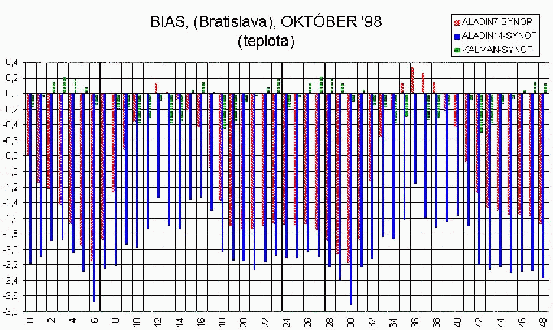
Figure 1. Verification of 2m temperature for Bratislava grid point

Figure 2. Comparison model output for 14.7 km (ALADIN/LACE) and 7.1 km (ALADIN/Slovakia)
On figure 2, you can see the differences between ALADIN-LACE version (on the left) and Slovak workstation version (on the right) in terms of orography (figures on the top) and 2m Temperature for a 6 (figures on middle of the page) and a 12 (figures on the bottom) hour range forecast, on the situation of August 23th of 1998.
We expect to switch ALADIN WS run to operational suite after detailed verification during beginning of the next year. We have also plan to use optimal interpolation scheme on workstation. Some technical part of this work ( CANARI and MANDALAY ) was done during autumn's stay at Toulouse.
14. Workstation version at Slovenian Meteorological Service
(more details mark.zagar++at++rzs-hm.si or jure.jerman++at++rzs-hm.si )
Number of things in the operational suite of ALADIN/SI has changed since the last report :
Presently the version of the model is Cy18T3/AL09.bf3. The starting time of the integration (i.e. the arrival of the +06 coupling file) is at 2:54 UTC and the ending time (48 hours) is at 4:29 UTC. The same is valid for the afternoon run, only add 12 hours.
During the autumn season we had great experiences with prediction of strong precipitation in few occasions. Some of them were classified as MAP situations and most of the data has been archived for research purposes.
Several additional products are produced operationally : meteograms for number of locations, point values and areal averages of precipitation, hi resolution wind forecast by dynamic adaptation for some ranges and some sub-domains.
Visualised are also the multitude of two-dimensionals cross-sections in horizontal and vertical plain, time-height diagnostics using HRID, etc...
Among the products, available to more flexible users are three-dimensional visualization in time and colour (Vis5D), trajectories computation, etc.
New cycle has been also used to test ALADIN in distributed memory mode. Tests have been performed on the non-homogenous cluster of five DEC/alpha Digital Unix and Linux workstations (never two of them were the same).
Cycle Al09_CY19t1 code has been used together with xrd19. First results were very encouraging, there is great speed-up in ALADIN execution time. We were able to diminish the time needed for one time step computation from 13.5 sec on one workstation to 5.2 on 5 workstations. There will be some additional tests performed as well as the tuning of software and hardware part of the system. We are also working on a report of activities so all other interested ALADIN countries will benefit from our work.
A new approach was used for the simulation of convective mesoscale systems at high resolution. The computation order of convective and stratiform precipitation was changed in order to avoid the double count of precipitation solved by the model: now first the stratiform precipitation is computed and the available humidity for convective precipitations is diminished correspondingly.
A new simulation of the squall line of 1992, July 21 over Southwestern Germany has been carried out. The above modification seems to have a positive impact on the precipitation, mean sea level pressure pattern as well as on vertical structure of the convergence lines. By this way the ratio of convective and stratiform precipitations was modified while the total precipitation amount remained almost unchanged. Several experiments concerning the sensitivity of the modified model to the tunnable parameters of the convective parameterization scheeme have been done.

The best result was obtained by including the downdraft parameterization and the active layer version of convective momentum parameterization devoloped by L. Gerard following the Kershaw-Gregory scheme (R.Kershaw and D. Gregory,1997: "Parametrization of momentum transport by convection.I: theory and cloud modelling results", D.Gregory and R. Kershaw, 1997: "Parametrization of momentum transport by convection.II: Tests in a single-column and general circulation models", Q.J.R. Meteorol. Soc., vol. 123, pp. 1133-1151 and 1153-1183) toghether with an enhanced horizontal diffusion above 500 hPa level, for a proper choice of the free parameters of the convection parameterization (TENTRX=0.8e-04, LCVDD=.TRUE., LCVEVAP=.FALSE., GDDEVA=0.25, GDDSE=0.5, TRENTRV=0.7). The one hour cumulated precipitation and the 10m wind field generaly agree with the composite radar and infrared sattelite images (see figure below).
There is still a delay about one hour of the simulated position of the squall line but the vertical structure of the squall line looks more realistic (well devoloped nuclei of vertical velocity in the area of high radar reflectivities) than that one obtain with the operational version of the model (see averaged vertical cross section along the 48.5 latitude: OS9D - operational version, OS9H - modified version).
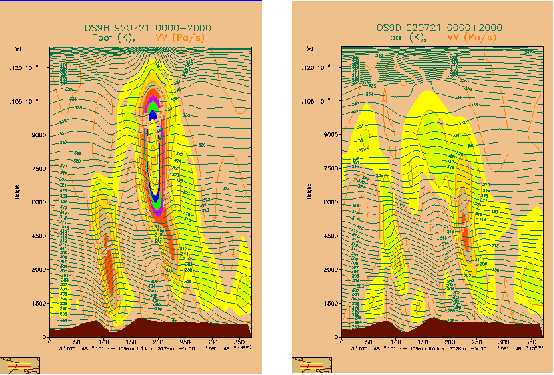
A mass, momentum and energy conserving, two-time-level, semi-Lagrangian scheme has recently been developed as a part of the study on "The Recently Developed, Conservative, First Order Accurate in Time, Two-time-level, Semi-Lagrangian Scheme and Its Implementation in ALADIN". It was first examined for a one dimensional "Shallow Water" model together with two other semi-Lagrangian schemes. Some results from the 1D study can be found at (http://www.cfd.meteo.bg/~ilian/poster/poster.html ). During the last period the proposed scheme was developed for ALADIN. Difficulties were encountered for the treatment of the non-linear residual of the right-hand-side of the momentum equation in case of a terrain following vertical coordinate. Thus a new treatment of the orography has been introduced. It is based on the statement that the variation of the prognostic variables due to the orography , being a stationary solution of the primitive equations in the h vertical coordinate, should not be treated semi-implicitly. A special correction for the variation along the SL trajectory of the stationary part of the semi-implicit term in the momentum equation has been developed. The correction is based on the assumption of motionless stratified atmosphere. The first tests show that the new scheme seem to be promising because it allows stable integration with results similar to those obtained with other schemes. However its probable advantages over the other schemes still have to be proved.
During the last months more technical than scientific work has been done.

The configuration preparing the initial and coupling files for the channel model experiment has been (again) rewritten and phased with ALADIN cycle AL08. It is configuration e926 which doesn't exist any more in Toulouse for ALADIN starting from the cycle AL08 (and even for cycles AL06 and AL07 there was a big bug unabling the usage of this configuration) and that is why the computation of the init files is performed in Prague on NEC SX4 computer.
The channel model has been succesfully moved from cycle AL05 to AL08T3.
At the current state another configuration of model has been prepared which will place the ideal case geometry (LMAP=.F.) to the real globe keeping the same domain size and resolution. To do this will allow to use all possibilities of FULLPOS so the configuration ee927 will be used to create some subdomain upon the channel model with higher resolution needed to get closer to baroclinic instability.
The above figure illustrates the current situation of baroclinic instability growth in the channel model with horizontal resolution 50 km along y direction and 20 km along x direction. This is the time dependency of a total kinetic energy minus initial kinectic energy in logarithmic scale for the lowest two model levels. The curves correspond with growth rate of instability which following theory should reach the infinity. As you can see, the growth is starting to saturate after 240 hours of integration and after 300 hours after initial state it remains almost constant. This effect is a consequence of resolution, so there is hope that with isotropic horizontal resolution 10 km the higher instability will be reached characterised by spectra more sensitive to diffusive processes of horizontal diffusion and the semi-Lagrangian interpolators which should be investigated by this PhD study.
(more details thomas.haiden++at++zamg.ac.at)
The skill of ALADIN-LACE and ECMWF areal precipitation forecasts is studied in a comprehensive verification project. Austria, and parts of Bavaria, are divided into 26 catchment-type sub-regions. For each region, modeled and observed areal mean precipitation values are computed. Forecast errors are analysed as a function of region, season, mean flow direction, and predicted precipitation amount. ALADIN-LACE forecasts are verified on a 3h-basis, with observations from the Austrian TAKLIS (partially automated climate station) network supplemented by German TAWES data, and enhanced by observations from a large number (1000+) of hydrological stations, reporting daily precipitation amounts. In the interpolation of the observations, regionally and seasonally varying elevation effects are taken into account. The verification of ALADIN-LACE covers the 2yr-period July 1996-June 1998. A report about the methods used, the main results, and the applicability to other parameters and regions, will be provided by the end of this year (.ps-file on lacepds2.zamg.ac.at).
(more details jean-marc.moisselin++at++meteo.fr or francis.pouponneau++at++meteo.fr)
Next tables are the cloud cover and precipitation contingency table for the 24H forecast range of ALADIN-FRANCE model (run at 12 hours). Classes are used in the verification of NWP models in EUROPE (EWGLAM). Contingency table are here computed over France.
Three skill scores have been calculated over the whole table :
Contingency tables for 6 hours precipitation should be computed with classes :
In contingency tables, the blue color means an underestimation, the red one represents an overestimation.
NEBULOSITY
|
9807-9809 MODEL : ALADIN 12 H start AREA : FRANP01-France fc range 24 H 92 days | |||||
Forecast |
|||||
0-2 |
3-6 |
7-8 |
SUM | ||
|
Obs. |
0 - 2 3 - 6 7 - 8 |
22.9% 6.3% 0.4% 13.1% 19.0% 5.0% 4.6% 18.4% 10.1% |
29.7% 37.1% 33.2% | ||
SUM |
40.7% 43.8% 15.6% |
12312 | |||
Correct : 52.1% Rousseau : 0.27 Heidke : 0.28 | |||||
The percent of correct is 52%. The high nebulosity class (7-8) is more observed than forecasted : 33% against 15% . The difference is in low and medium nebulosity classes which are more forecasted than observed, especially in the low cloud cover class (observed in 30% of cases but forecast in 41% of cases).
PRECIPITATIONS
|
9807-9809 MODEL : ALADIN 12 H start AREA : FRANP01-France fc range 24 H 92 days | ||||||
Forecast |
||||||
NO rain |
LIGHT |
MODERATE |
HEAVY |
SUM | ||
Obs. |
NO rain |
67.4% |
11.4% |
1.6% |
0.1% |
80.4% |
LIGHT |
4.7% |
5.4% |
1.8% |
0.2% |
12.1% | |
MODERATE |
1.0% |
2.5% |
2.7% |
0.3% |
6.6% | |
HEAVY |
0.1% |
0.3% |
0.4% |
0.2% |
0.9% | |
SUM |
73.1% |
19.6% |
6.4% |
0.8% |
14057 | |
|
Correct : 75.7% Rousseau : 0.36 Heidke : 0.37 | ||||||
The percent of correct is more than 75%. "Light precipitation" class has been more forecasted (20%) than observed (12%) whereas "No rain" class has been more observed (80%) than forecasted (73%).
Each ALADIN country will soon receive a paper describing the EWGLAM program concerning the comparison of limited area models : score formulae, list of stations, various recommendations.
|
|
The statistics about the participations in the ALADIN project and the ensuing compilation of the ALADIN developments is drawn up from the contributions sent by the representative of each country. Please find in annex a few graphics illustrating the last summary of the participation in the ALADIN project. |
In the next two parts ("Deported developments during the second quarter of 1998" and "ALADIN developments in Toulouse during the third quarter of 1998"), you will find the list of the ALADIN developments (in and outside Toulouse) except those detailed in the previous pages : PhD studies, developments for workstation versions or operational suites, work on data assimilation, ... during the quarters concerned by this Newsletter. The following informations concerning the deported developments are obtained from informations you sent.
|
|
As announced in the last Newsletter, the 150th participant in ALADIN project joined us this quarter. Our new colleague comes from Croatia; her contribution to the ALADIN project begun last September with her stay on the introduction of the ozone variable in the model. Congratulations to Mrs Zvjezdana Klaic. |
|
During this quarter, the participation in ALADIN project reached 1500th person.month (since the beginning of the project in 1991. 2/3 of this effort was realized in Toulouse ... and, of course, 1/3 outside Toulouse. |
|
The average contribution of an ALADINer is around 10 months work while the median is only about 5 months ... search for the "bug" : 1/3 of the effort was realised by only 12 persons !... at the same time, more than 1/3 of the persons contributed less than 2.5 months each. As one can see on the histogram, a 2 years participation (i.e. 24 months) seems to be a difficult step to jump over.
On the occasion of the Third Assembly of the ALADIN Partners, other statistics were prepared. Everybody did not have the opportunity to see them in Praha but you did not miss everything : as a consolation, you can find above some of the corresponding graphics.
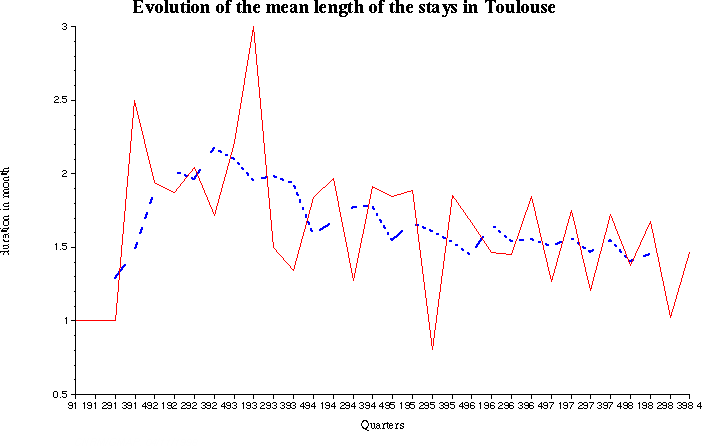
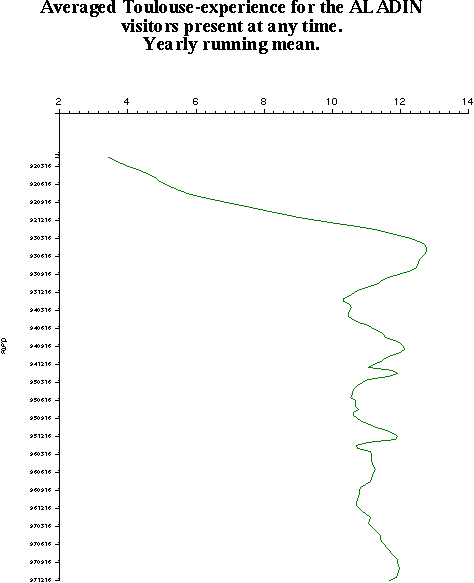
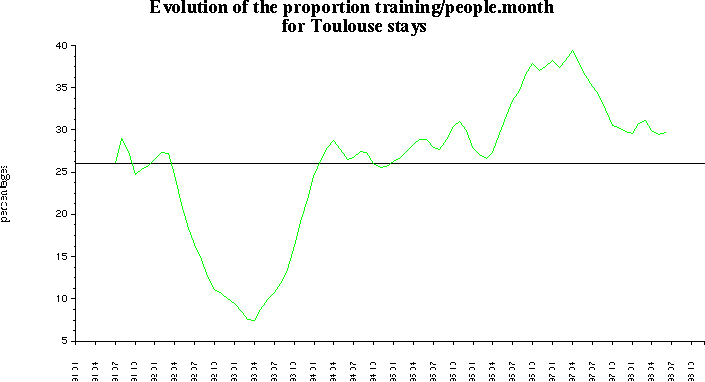
On these curves (in red, the mean length of the stays in Toulouse each quarter and, in blue, the corresponding yearly running mean), a worrying decrease appears : stays are getting shorter every year. This is all the more penalizing when persons on stay are beginners. From the latter point of vue, things have improved this year, after a very bad period in 1996-1997. The other two pictures illustrate this from the point of vue of the proportion of training people among people on stay (the slope is now downward) and from the average experience (upward slope). Let us hope that similar pictures (to be drawn up for the next Assembly in Lisbonne) will confirm these good trends ... and we have one year left to work hard on the improvment of the bad points !.. So, please try to arrange slightly longer stays !..
During this quarter, 54 persons have worked on ALADIN "at home" (i.e. in their NMS : not in Toulouse) and their global effort represents more about 70 people.month during this period.
1. In Austria
2. In Belgium
3. In Bulgaria
4. In Croatia
5. In Czech Republic
6. In Hungary
7. In Moldavia
8. In Morocco
9. In Poland
10. Portugal
11. In Romania
12. In Slovakia
13. In Slovenia
14. Deported work by Météo-France
|
Around 30 persons (only 2/3 of visitors during this summer holidays quarter) have almost reached the common effort of 40 people.month. Most of the persons in Toulouse in July have contributed to the success of the phasing. Late August and September saw the return of the PhD students and the beginning of the first stays on ambassy support. 1. Main events in Toulouse this quarter The phasing for preparation of ALADIN cycle 9 was completed this quarter thanks to the Toulouse GMAP team (under C. Fischer coordination) and the participation of R. Ajjaji and J. Boutahar (Morocco), P. Neytchev (Bulgaria), C. Soci (Romania) and the help of other visitors present at that time in Toulouse (R. Bunova from Czech Republic, Ilian Gospodinov from Bulgaria, ...) |
|
|
|
a new configuration of ALADIN-FRANCE is operational since September the 1st (see above, '(Pre-)Operational versions of ALADIN : 5. ALADIN-FRANCE). tools improvements : the following utilities have been improved : - ECTOplasme also gives the cinetic (vorticity and divergence), energy spectra of the difference of two fields; - CHAGAL now plots both spectral and grid point files. |
2. Other visitors research or development studies that ended during this quarter
Most visitors present in Toulouse during this summer period have worked on phasing or on their PhD apart from A. Dziedzic and W. Owcarz (Poland) who have worked on some refinements in the surface analysis.
3. Other research or development studies by the Toulouse permanent staff
Nothing to report this quarter.
|
|
news12.ps : ALADIN Newsletter 12 (color postscript), updated on 27-11-98 (34 pages) news12bw.ps : ALADIN Newsletter 12 (black and white postscript), updated on 27-11-98 |
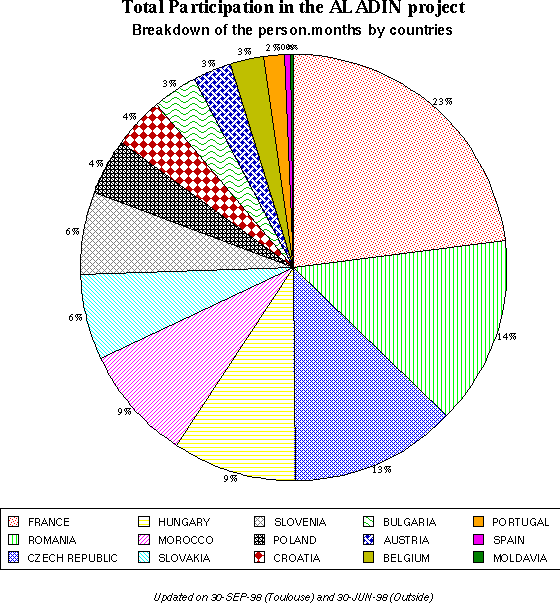
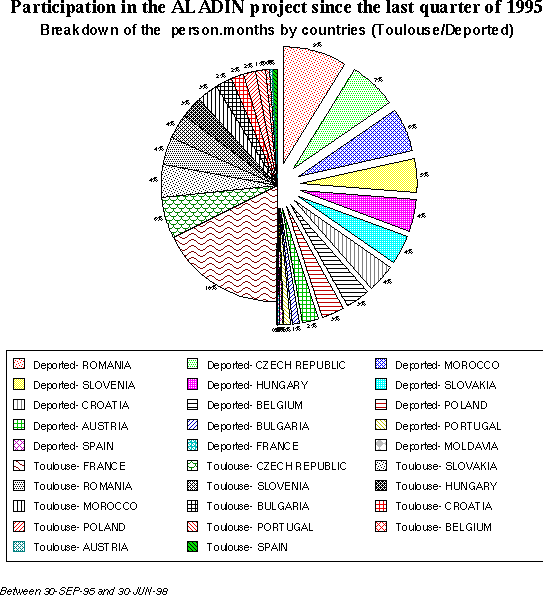
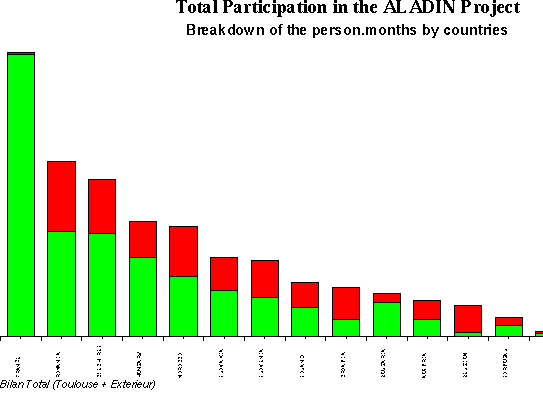
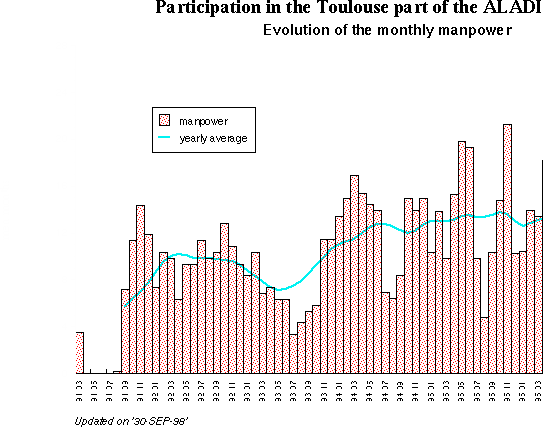
 |
Home |